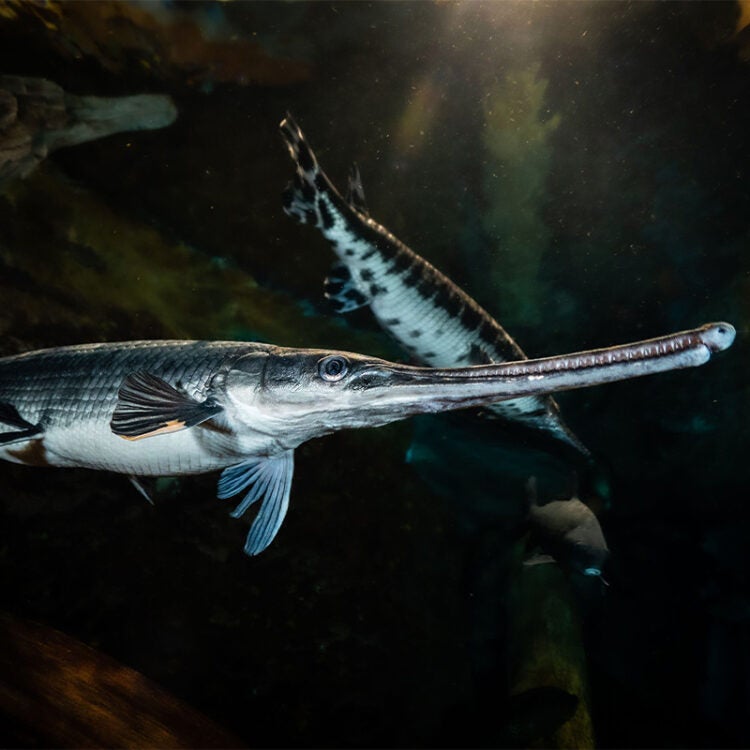-
Size
Up to 6 feet (1.8 m) -
Diet
Fishes, small crustaceans, insect larvae -
Range
North America -
Habitat
Sluggish pools and backwaters of rivers and lakes
Physical Characteristics
- Longnose gar has a very long, slender snout with a length of 18 to 20 times its width.
- Their long cylindrical body is covered with large, overlapping diamond-shaped scales, which distinguish them from all their freshwater relatives. These scales interlock to produce a virtual suit of armor leaving the gars with few natural predators.
- The dorsal fin is located far back on the body, almost over the anal fin. The caudal fin is broad, as is the caudal peduncle.
- Coloration is typically grayish to olive-green dorsally and on the sides; white or yellowish below.
- Longnose gar can grow to 6 feet (1.8 m) in length and weigh up to 50 lbs. (23 kg).
- Females are larger than males.
Animal Fun Fact
The longnose gar have overlapping scales that interlock to create a great armor for protection.
Diet / Feeding
- An ambush feeder that attacks prey from the side and then adjusts its grip to swallow the prey head first.
- Adult longnose gar feed almost exclusively on fishes, most heavily on shad, herring and bullheads, with minor predation on minnows and sunfishes.
- Juveniles feed voraciously on small crustaceans and insect larvae and grow very rapidly.
Range / Habitat
- The longnose gar occurs in the Mississippi River system, through the Great Lakes except for Lake Superior. It also occurs in the St. Lawrence watershed to Quebec and down to northern Mexico.
- Most abundant and widely distributed member of the ancient gar family.
- Found in sluggish pools, backwaters and oxbows of medium to large rivers and lakes.
- Prefers areas of vegetation and occasionally may be found in brackish waters.
Reproduction & Growth
- Adults make long migrations to spawning sites in streams that have clear water and a relatively steep gradient.
- Spawning is believed to occur between April and June when the longnose gar will spawn on gravel shoal areas and among rocks or occasionally in the weedy shallows of lakes and rivers.
- Female longnose gar shed their eggs in repeated batches and males fertilize them as they are released. Instead of a close vent-to-vent association between males and females, the males cloud the water with milt.
- Females will produce about 30,000 plus eggs per year.
- Frequently, longnose gar eggs and larvae have been found in smallmouth bass nests, where the male bass guards the nest protecting the young gar in addition to its own young.
Conservation Status
- “Least Concern” on the IUCN Red List.
Additional Information
- Its swim bladder is highly vascularized and is connected to its throat. This allows the longnose gar to gulp air when it is in waters with very low concentrations of oxygen.
- It is the most widespread of the gar in the southern U.S., although it is extinct in some of its northern habitats.
- Longnose gar is reported to live 20 to 30 years.
- Gars are a primitive group of bony fish that still retain a spiral valve intestine, which is an ancient feature of the digestive system commonly associated with sharks and rays.
Sources
- www.fishbase.org
- www.flmnh.ufl.edu/fish/gallery/descript/longnosegar/longnosegar.html
- Fishes of Alabama. Boschung, H. T. and Mayden, R.L., pgs. 118 -119
- McClane’s Field Guide to Freshwater Fishes of North America. McClane, A.J., p. 180
- Peterson Field Guides – Freshwater Fishes. Page, L.M. and Burr, B.M., pg. 30
- The Fishes of Tennessee. Etnier, D.A. and Starnes, W.C., pgs. 112 -113







